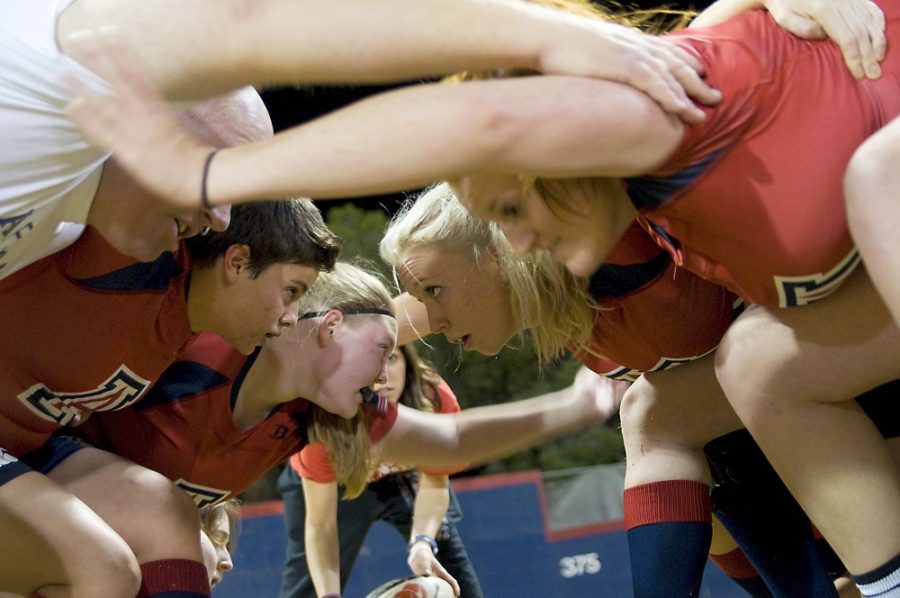Few students are aware that the UA is home to more than 30 club sports, including men’s and women’s rugby, lacrosse, ultimate frisbee and even ballroom dancing. Many of these teams compete on a national level, traveling cross-country to participate in tournaments and championships.
According to Mary O’Mahoney, assistant director for sports clubs and aquatics at the UA Department of Student Recreation, more than 1,100 students participate in sports clubs at the UA. Despite their popularity, many students are oblivious to the variety and size of the sports club program.
“A lot of people don’t even realize that there is a women’s rugby team,” said Carly Gieszl, a sophomore studying family studies and human development and president of the Women’s Rugby Football Club. “A lot of people hear about the men’s team but they’re like, ‘wait, women’s rugby?’”
Each year, students pay a health and recreation fee of $300. A portion of this fee goes to support the Sport Club Program at the Department of Campus Recreation, which allocates $100,000 to provide facilities and trainers for each team, O’Mahoney said. Campus Recreation reimburses teams for other expenses as well, like traveling to competitions.
Not every team receives the same amount of funding. Instead, Campus Recreation decides how much money to allocate to each team using a classification system that is based on the team’s activity during the previous year. Teams receive points in seven categories, including the size of the club, the number of practices and meetings held each week, the cost of maintaining the club and the club’s competitiveness. The total number of points a club receives determines which funding category it belongs in.
Additionally, teams must submit a budget request that is determined by the previous year’s expenses. Each fall, sports clubs must submit their budget, register as a club with the Associated Students of the University of Arizona and determine their classification in order to be eligible for funds.
Despite financial support from Campus Recreation, many sports clubs are primarily self-funded, O’Mahoney said.
Sports club fees can cost anywhere from nothing to $2,600 per year. These fees, combined with fundraisers and donations, pay some of the costs of playing a club sport. The rest of the burden often falls upon the athletes.
The Women’s Rugby Football club is one team that relies primarily on player support. For these athletes, one of the biggest expenses is traveling back and forth to compete against teams in California, their nearest competitors.
According to Gieszl, the players carpool to and from games, often driving five or six vehicles and splitting the cost of gas among the team. Once they arrive at their destination, the athletes have to find a place to sleep for the night. If they are lucky, they are housed by the opposing team, sleeping on their living room floors, Gieszl said.
If the opposition can’t house the team, each player has to come up with the money to pay for hotel rooms. According to Alex Rath, a pre-nursing freshman and member of the women’s rugby club, the team purchased four hotel rooms to house 30 players on a trip to California.
Another challenge the team faces is having time to compete while still tending to their academic and personal responsibilities. Because they don’t play an NCAA sport, the players have to do most of their physical training outside of practice, Gieszl said. They also organize study groups to maintain their academic standing during the rugby season.
Regardless of the cost and the extra time, sports clubs continue to grow, according to O’Mahoney. Fifteen years ago, the number of athletes in the Sport Club Program was between 700 and 800, she estimated.
“You’ve got students that come to the University of Arizona specifically because they know the experience they’re going to get playing rugby here, or playing ice hockey here, or playing lacrosse here,” she said. “Students stay here because they get involved with a (sports) club, just like any other club on campus. It helps anchor them to the campus and the community.”
According to Gieszl and Rath, the community and the passion the players share for the sport are what makes playing a club sport like women’s rugby worth the extra time and money.
“It’s an instant group of friends,” Rath said. “I just decided it was worth paying for it because it’s been so much fun.”









